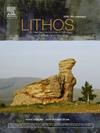中国西北西昆仑早古生代同步碰撞花岗岩及飞地的岩石成因:对大陆地壳生长的影响
IF 2.9
2区 地球科学
Q2 GEOCHEMISTRY & GEOPHYSICS
引用次数: 0
摘要
西昆仑造山带(WKOB)位于青藏高原西北边缘,由南面的冈瓦纳地块和北面的塔里木地块碰撞形成,与新元古代晚期至古生代早期原特提斯洋的关闭密切相关。我们对该地区的同步碰撞花岗岩柱岩和岩浆岩微晶飞地(MMEs)进行了锆石UPb地质年代、全岩成分和Sr-Nd-Hf同位素综合研究。锆石UPb测年结果显示,汤峪铺盖子、上街和皮石盖岩块体以及来自皮石盖岩块体的MMEs的年龄分别为443.8±4.4、451.9±4.2、462.9±3.5和456±4.2Ma。这些花岗岩为金属铝质至弱过铝质(A/CNK = 1.00-1.17),属于高K钙碱性系列。它们的(87Sr/86Sr)i比值为0.7058-0.7154,εNd(t)值为-8.78至-0.93,εHf(t)值为-19.72至+6.87。MMEs具有不同的SiO2含量(45.7-60.2 wt%),比主花岗岩的岩浆性更强,但具有与主花岗岩相似的Sr-Nd-Hf同位素组成[(87Sr/86Sr)i = 0.7102-0.7110; εNd(t) = -6.57 to -3.56; εHf(t) = -7.17 to -1.81] 。MMEs是岩浆演化早期形成的堆积物碎片。花岗岩是由混合岩源部分熔融产生的。新数据支持这样一种观点,即沿西九龙龙骨山脉分布的中-晚奥陶世同碰撞花岗岩与MMEs是岩浆对陆相碰撞的反应。这表明,在造山运动的最后阶段,老造山运动系统中的幼年地壳增长(通过弧加成发生)也涉及一些垂直加成。我们的研究表明,在大陆碰撞带的同步碰撞阶段,与板块断裂相关的熔岩蜕变是地壳生长的一个关键机制。本文章由计算机程序翻译,如有差异,请以英文原文为准。
Petrogenesis of early Paleozoic syn-collisional granitoids and enclaves in Western Kunlun, Northwest China: Implications for the growth of continental crust
The Western Kunlun Orogenic Belt (WKOB), along the northwestern margin of the Qinghai–Xizang Plateau, was formed by the collision of Gondwana-derived terranes to the south and the Tarim Block to the north and was closely associated with closure of the Proto-Tethys Ocean during the late Neoproterozoic to early Paleozoic. We present a combined zircon U![]() Pb geochronology, whole-rock composition, and Sr–Nd–Hf isotopic study of syn-collisional granitoid plutons and mafic microgranular enclaves (MMEs) in the region. Zircon U
Pb geochronology, whole-rock composition, and Sr–Nd–Hf isotopic study of syn-collisional granitoid plutons and mafic microgranular enclaves (MMEs) in the region. Zircon U![]() Pb dating yields ages of 443.8 ± 4.4, 451.9 ± 4.2, 462.9 ± 3.5, and 456 ± 4.2 Ma for the Tongayoupuagezi, Shanjie, and Pishigai plutons and MMEs from the Pishigai pluton, respectively. The granitoids are metaluminous to weakly peraluminous (A/CNK = 1.00–1.17) and belong to the high-K calc-alkaline series. They have (87Sr/86Sr)i ratios of 0.7058–0.7154, εNd(t) values of −8.78 to −0.93, and εHf(t) values of −19.72 to +6.87. The MMEs have variable SiO2 contents (45.7–60.2 wt%) and are more mafic than the host granitoids, but have similar Sr–Nd–Hf isotopic compositions to the host granitoids [(87Sr/86Sr)i = 0.7102–0.7110; εNd(t) = −6.57 to −3.56; εHf(t) = −7.17 to −1.81]. The MMEs are fragments of cumulates formed during the early stages of magma evolution. The granitoids were produced by the partial melting of a mélange source. The new data support the view that the Middle–Late Ordovician syn-collisional granitoids with MMEs distributed along the WKOB represent a magmatic response to terrane collision. This suggests that juvenile crustal growth in older orogenic systems, which occurs by arc addition, also involves some vertical addition during the final stage of orogenic collision. Our study suggests that mélange diaper melting is a key mechanism of crustal growth during the syn-collision stage in continental collision zones, associated with slab breakoff.
Pb dating yields ages of 443.8 ± 4.4, 451.9 ± 4.2, 462.9 ± 3.5, and 456 ± 4.2 Ma for the Tongayoupuagezi, Shanjie, and Pishigai plutons and MMEs from the Pishigai pluton, respectively. The granitoids are metaluminous to weakly peraluminous (A/CNK = 1.00–1.17) and belong to the high-K calc-alkaline series. They have (87Sr/86Sr)i ratios of 0.7058–0.7154, εNd(t) values of −8.78 to −0.93, and εHf(t) values of −19.72 to +6.87. The MMEs have variable SiO2 contents (45.7–60.2 wt%) and are more mafic than the host granitoids, but have similar Sr–Nd–Hf isotopic compositions to the host granitoids [(87Sr/86Sr)i = 0.7102–0.7110; εNd(t) = −6.57 to −3.56; εHf(t) = −7.17 to −1.81]. The MMEs are fragments of cumulates formed during the early stages of magma evolution. The granitoids were produced by the partial melting of a mélange source. The new data support the view that the Middle–Late Ordovician syn-collisional granitoids with MMEs distributed along the WKOB represent a magmatic response to terrane collision. This suggests that juvenile crustal growth in older orogenic systems, which occurs by arc addition, also involves some vertical addition during the final stage of orogenic collision. Our study suggests that mélange diaper melting is a key mechanism of crustal growth during the syn-collision stage in continental collision zones, associated with slab breakoff.
求助全文
通过发布文献求助,成功后即可免费获取论文全文。
去求助
来源期刊

Lithos
地学-地球化学与地球物理
CiteScore
6.80
自引率
11.40%
发文量
286
审稿时长
3.5 months
期刊介绍:
Lithos publishes original research papers on the petrology, geochemistry and petrogenesis of igneous and metamorphic rocks. Papers on mineralogy/mineral physics related to petrology and petrogenetic problems are also welcomed.
 求助内容:
求助内容: 应助结果提醒方式:
应助结果提醒方式:


